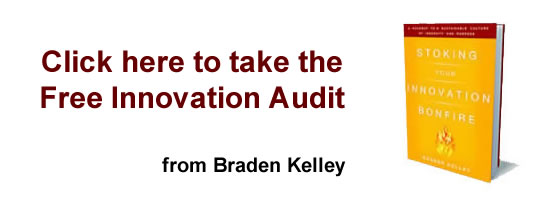“Faux Innovation” and Other Discontents

Over the course of this year, I’ve had the good fortune of working with three Global 50 companies – two U.S. based and one European. I’ll simply refer to them as Company A, B and C.  Despite being in different industries (high-tech, financial services and industrial), one common theme emerged: senior leaders in each of the companies articulated a strong desire and an equally strong level of frustration with their innovation efforts.  After digging a little deeper, I think I uncovered the source of the frustration — there was no real evidence that the desire for innovation was being met with meaningful adoption or implementation.
In fact, I found the opposite – a lack of urgency, misinterpretations, and in some cases, downright resistance to the basic ethos of innovation. While my conclusions may sound rather harsh, they come from a place of empathy and curiosity that compelled me to seek answers to several key questions: “What is the source of this hostility to innovation?â€; “Is the under-performance in innovation episodic or systemic?”; and “What is causing this value-destroying gap between stated intent and actual reality?”  Here are 3 reasons that I came up with:
1)  Dominant “What’s Now?†agendas
Many companies and brands focus their leadership attention, organizational capacity and resources on producing short-term results and managing the business day-to-day — I call this the “What’s Now?†agenda.  Given that intense pressure from capital markets essentially forces companies into a short-term, quarter-over-quarter focus, one can certainly be empathic.  However, as observed in Company A, with an almost exclusive focus on the “What’s Now?†agenda, companies and brands can quickly lose sight of important outside signals that reflect long-term shifts in market forces, competitive dynamics, customer behavior and brand preferences.
Affirming the significance of this, a recent Nielsen study shows that 63% of surveyed customers want and expect their preferred brands to innovate for the future.  With a lack of emphasis on the evolving and future business landscape –  the “What’s Next?†agenda –  new market entrants, disruptive business models and emerging technologies (Internet-of-Things (IoT), advanced robotics, artificial intelligence, etc.) can quickly be converted from high-potential acquisition, innovation and growth opportunities into existential threats.  Is the “What’s Next?” agenda in your company being overwhelmed by a dominant “What’s Now?” agenda?  Other questions to consider:
- Do we have enough focus on the “What’s Next?†agenda?
- Are we aligned around a collective vision of our future?
- Are we formulating a competitively divergent view of the future?
- Are we applying intellectual curiosity to identify areas for innovation within that future?
- What type of innovation (strategic, customer, service, business model, value, product, etc.) do we need to capture the opportunities of the future?
2) Â Bunker mentalities
With many companies now offering flexible work schedules, remote work arrangements, on-site gyms and free snacks, the new workplace is increasingly built to optimize employee work-life balance. However, as an unintended consequence of these newly found “comfortable” work environments, the organizational temptation to maintain and defend the status quo becomes a force to reckon with.  Specifically, as communicated by a senior leader in Company B, the relative comfort, contentment and convenience found in the new work setting can inadvertently lead to powerful “bunker mentalities” that are highly resistant to change, and a culture that favors risk-elimination over the critical risk-reward calculus needed in today’s complex business environment.
Simply put, companies can lose their animal spirit, potentially suppressing the collective organizational hunger to compete, lead and win in the marketplace. Contrary to the original intent, these types of culture and work environment can lead to missed opportunities, underperformance and organizational stasis that can ultimately fuel employee disengagement, limited collaboration on “What’s Next?â€, and an insidious lack of passion for the business, which only fuels the status quo further.
This is serious stuff – Â Gallup estimates that 70% of American employees aren’t working to their full potential and cost companies roughly $550 billion in lost productivity per year. Is your company inadvertently operating with a bunker mentality that favors the status quo over innovation? Other questions to consider:
- Is leadership providing the commitment and permission to innovate, fail, pivot and learn?
- Do we have the right organizational systems and structures (incentives, collaboration, knowledge diffusion, training, experimentation) in place to compete and win the future?
- Do we have a common language around innovation and growth that is institutionalized?
- Is creating, promoting and executing new ideas a crucial part of everyone’s job description?
- Are we comfortable with balanced risk-taking and creative disruption?
3) Â Alternative Realities
With new corporate design labs, innovation challenges, open workspaces, and the curious emergence of hoodie-clad hipsters, Company C has mastered the appearance of “doing innovation”. Â With all due respect to skinny jeans, this type of corporate psychological warfare – I call it “faux innovation” — can create a virtual Stockholm Syndrome where employees are held captive in an alternative reality where innovation pretense replaces creativity, customer-centricity, experimentation and reasonable expectations of real commercial outcomes.
Beyond the hype and surface optics, in the words of a senior leader, the innovation programs in Company C have struggled to consistently generate real commercial outcomes, demonstrate adequate returns on capital or contribute meaningfully to value creation. Â Particularly acute in the rapid-fire digital and service-driven economy, if the tyranny of faux innovation takes hold, companies and brands can quickly become vulnerable to the threat of rapid commoditization and marketplace irrelevance that lead to real questions about customer acquisition, retention and long-term corporate viability.
As Marc Sniukas points out in his book The Art of Opportunity, “Innovative ideas for new products, service and businesses need to be aligned with business requirements in terms of financials, (e.g., ROI, margin), operational realities (e.g., can we actually do it), technology available and the overall strategic direction of the company.â€Â While this might sound obvious, evidence shows that making this happen isn’t easy.  In fact, while the 2016 Global Innovation spend is still at an all-time high of ~$680B, a recent McKinsey poll states that 94% of the managers surveyed were dissatisfied with their company’s innovation performance. Is your company suffering under the tyranny of “faux innovation”? Is the appearance, rather than the substance, of innovation more important? Other questions to consider:
- Are we (really) doing innovation or doing a good job faking it?
- What was the most meaningful outcome from our innovation programs?
- Are we linking innovation investments to real business objectives and emerging opportunities?
- How effectively are we experimenting, learning and aligning our innovation portfolio to unmet, unsatisfied or under-valued customer needs or market gaps?
- Is commercialization part of our daily innovation conversations or an afterthought?
Making Real Innovation Real
With 40% of your company’s future value creation and growth likely to come from new customer in new markets with new products by 2020 (CEB), it is more essential than ever for companies to build cultures that are focused on growth, innovation and customer-centricity. Simply put, companies and brands that don’t innovate are on a slippery slope to obsolescence and irrelevance in the minds of customers and consumers who have many options on where to spend their money.
The good news is that those that build cultures for innovation get rewarded – Forbes states that companies with innovation-focused cultures get an “innovation premium†– a higher multiple that investors place on a company’s value. Further, a recent study showed that companies with both highly aligned cultures and highly aligned innovation strategies have 30% higher enterprise value growth and 17% higher profit growth than companies with low degrees of alignment. Innovation-focused cultures also produce highly-productive workforces which can improve operating incomes by 19% over a 12-month period.
Admittedly, Company A, B and C aren’t out of the woods quite yet. In fact, they are just beginning their journeys with us to rewire their cultures for growth, innovation and customer-centricity. However, each of them have taken the essential step of being humble and introspective, looking deeper into their organizations and cultures to uncover and acknowledge the presence of “Faux Innovation and other discontents” in their organizations — it wasn’t easy. However, with so much latent energy, potential and opportunity upside, to a company, they know that the journey will be well worth it.
Ready to get started on your journey? Learn more about how to unleash the power of Growth Thinking to equip your organization to turn your culture into a competitive advantage in today’s digital and service-driven economies.
 Wait! Before you go…
Choose how you want the latest innovation content delivered to you:
- Daily — RSS Feed — Email — Twitter — Facebook — Linkedin Today
- Weekly — Email Newsletter — Free Magazine — Linkedin Group
 “Passionate about building growth, innovation and service-focused organizations.”  Keary Crawford is a Co-founder of Opptiv and a Co-author of  Growth Thinking: Building the New Growth Enterprise.  Keary has spoken on innovation and entrepreneurship for the European Commission; and has been featured in Wired Magazine and on GrowthHacker TV. Keary is an alumna of the University of Maryland and a Fellow of The Wharton School.
“Passionate about building growth, innovation and service-focused organizations.”  Keary Crawford is a Co-founder of Opptiv and a Co-author of  Growth Thinking: Building the New Growth Enterprise.  Keary has spoken on innovation and entrepreneurship for the European Commission; and has been featured in Wired Magazine and on GrowthHacker TV. Keary is an alumna of the University of Maryland and a Fellow of The Wharton School.
NEVER MISS ANOTHER NEWSLETTER!
LATEST BLOGS
Four ways you can ensure employees take accountability for their work
One of the most important driving factors for any successful business is a high-performing team. Having people working for you…
Read MoreWhat is digital upskilling and why is it important?
Photo by Annie Spratt on Unsplash In a world of business that never stands…
Read More



I blog frequently аnd I genuinely thank Êⲟu for
your informatiоn. The article hаѕ trᥙly peaked
my inteгеst. I’m going to book mark your website аnd keep checking foг new details аbout oncï½… per weï½…k.
I opted in ffor Êour Feed toо.